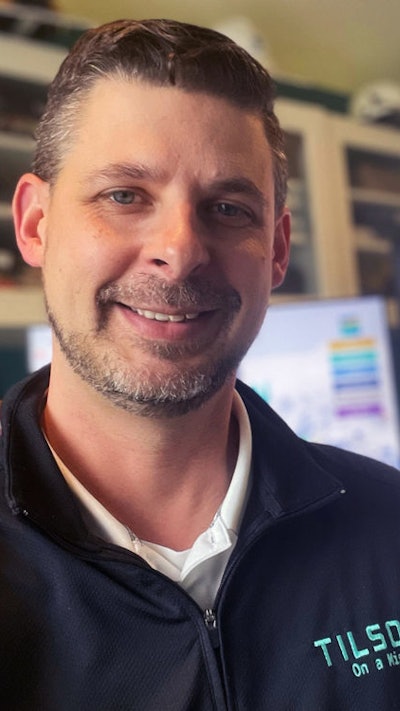
As CIO of Tilson, a national network development and information infrastructure professional services firm with more than 1,100 employees in over 25 locations, Jason Burns ought to know quite a bit about the optimal technology stack for their type of business. But he has an even better idea since he also heads Tilson’s construction software advisory and services practice. Utility construction is set for explosive growth, with telecom outside plant contractors bracing for growth driven by the $48 billion Broadband Access and Employment Program’s (BEAD) Notice of Funding Opportunity (NOFO). Renewables contractors are facing a similar delta, with wind turbine and service technicians and solar photovoltaic installers the two fastest-growing professions. Some forecasters suggest non-hydro renewable electric capacity could grow by almost 200% in the next 10 years.
Because this is a hot market, Senior Technology Editor Charles Rathmann sat down with Burns for a solid brain dump. Here is a rundown of the technology in place at Tilson, from the back office to the field, and Burns’ picks for others in the space and beyond. Tilson CTO Jason BurnsTilson
Tilson CTO Jason BurnsTilson
RATHMANN: So inside Tilson, for your own operations, what type of technology touches your value stream from go-no-go decisions to pursue something to work in progress to recognizing the revenue? What does your technology stack look like?
BURNS: Listen, we're in the middle of updating our technology stack. I'll give you what my future state is that we're currently building out We're using a mix of systems. We have Zoho for sales and opportunities ingestion. We never moved that to what has become our primary operations systems which is Sitetracker, based on Salesforce. Our primary financial systems are Vista by Trimble Viewpoint (now part of Trimble Construction One). And we use Workday for our human capital management system.
We have some ancillary systems for safety and whatnot, but our primary systems are and will be Sitetracker and Vista. Our goal, to answer your question of how we bring something all the way through, all of our information is connected to a central data repository warehouse. We use Microsoft Azure networks as our event grid. And then we use a Power BI layer on top of it.
One of the things that's a little different here at Tillson, is we've redesigned our systems. People get reporting outputs, analytics, everything done in Power BI. They don't use their native application. That way, we can mix all of our data sources in one place. It gives us a full picture of where we're at right now where we're going.
RATHMANN: With Power BI, are you finding that the sources you're pulling stuff from have easily recognizable enough data models, where it's easy to combine them into analytics, or were there certain things you had to do to kind of make sure that that data was clean and standardized and stuff like that?
BURNS: Well, the real trick is to have a source data input system and stay in one lane. I have a methodology that whoever touches the piece of information first enters it. I have these key people and one system where I can ensure that when a job is first known, the first person in our process are the ones who start the process, then that job number articulates to all the other systems automatically. In order to get what you're asking, you need to have a few key data points, job numbers, vendor numbers, employees and cost structures. They'll have to be the same, and they will have to be repeated across all of your systems. That way, when you pull their data into your warehouse, you have the ability to normalize it and relate it immediately, because you've used key data fields that relate the data to each other.
RATHMANN: Do you have data from Sitetracker communicating directly into Vista through a unidirectional or bidirectional interface? Or are you pretty much rolling everything up at the Power BI level?
BURNS: Both. It depends if the other system needs it is obviously the operational data that the financial system doesn't need, and vice versa. What we do is we do use API calls, but we use Microsoft's Event Grid as a central hub. It pushes data in and out of the source and target systems. Kind of like your heart, right? It acts as the heart of all data movement across the network. It pumps in pumps out.
RATHMANN: So it is not a direct integration then?
BURNS: Connecting with APIs is dangerous because they break, you can't change your systems easily. They're really complicated if you want to move on to something else or want to introduce a new piece of information. Doing it this way, if you want to add a new piece of information, you go to the event group and say you want this piece of information. And then you can automatically tag it to all systems from there as opposed to writing over and over and over again, every API call.
RATHMANN: Is that type of approach something you're recommending or steering a lot of your advisory and consulting clients or customers towards as well?
Burns: Yes. You want to make integrating easy, but you have to centralize how you do it and make it so you can replace systems in a more expeditious and less costly manner. This accomplishes that.
RATHMANN: Do you think there are advantages to doing it that way versus relying on construction specific integration platform as a service (iPaaS) like Agave or Trimble’s Construction Data Exchange?
BURNS: A lot of vendors have integration platforms. Autodesk has one. Trimble has one. I have no issue with what the vendors and what they're building, and they might be the right choice for some people. My specific point of view on this is that I don't want to use a primary application API, because it ties me to that application vendor. I rather use something independent. You can argue I'm using Microsoft makes you more attached to Microsoft, but is there any really other option in the corporate enterprise?
RATHMANN: We are seeing the emergence of a number of broad spectrum of specific applications for various types of construction. It might make sense for contractors to use a pretty verticalized solution. But then, we've got these broad, horizontal solutions and technologies that get tremendous research and development. They've got ecosystems. They're well understood. And for some of our core infrastructure we want to rely on. Which way should utility contractors jump?
BURNS: Sitetracker does that--they're built on Salesforce. But I'm leaving the application-centric model and moved to a data-centric model. The center of most people's universes is their enterprise resources planning (ERP) software, or whatever might be their accounting system. And then they try to strap on all that data from those best in classes or secondary systems, and they just dump it into their ERP. The problem is, is that they become reliant entirely on the ERP. And the secondary systems are really hard to get rid of because you can't replace them easily. In my model, the heart the sun is your data, and your applications are revolving around it.
RATHMANN: When it comes to utility contractors that you work with, and I figure you're probably work with a number of different types of contractors, how do their needs for technology solutions differ from someone who might be a building contractor or involved in heavy civil projects?
BURNS: The largest difference between general construction and utility trade specifically is how they produce their work both billing to their clients, and how they manage it. Then vertical construction, and even some horizontal construction, such as like roads heavy highway, they're using typical work-in-place systems, and they're on percent of complete basis. They're working off of formal 2d drawings and might be using some geospatial information. But that's largely being used in the safety space for most of those except for like the large highway infrastructure projects. In the utility space, they're working off of milestone systems, which is a totally different mindset. It's geospatial to start, and they never start in a typical blueprint. There's no such thing as a CAD drawing in most cases, or a Revit model, because they don't extend doing a 600-mile fiber run with 5,000 service address houses passed or something to that nature.
In that space, the utility contractors have very few choices to project-manage that work. There might be only two real systems of commercial grade out there, along with a bunch of emerging products. But it's been largely ignored, because it's a smaller space. But right now, with the massive funding coming through for fiber to the home projects through federal grants and budget funds, you are seeing more entries here.
RATHMANN: When it came to it comes to the project management solutions that are fit for this space. Which ones do you think kind of fall are best, best suited?
BURNS: I believe that Sitetracker is most likely is leading in this space. There are some emerging people out there. Trimble has a decent product. There are three or four products that are emerging right now that I would say are still maturing.
LEAN MORE WITH OUR IRONPROS SITETRACKER DEEP DIVE
RATHMANN: What role do geospatial technologies like geographic information systems (GIS) play for utility contractors right now?
BURNS: There's a ton of geospatial stuff coming out. Everyone knows ArcGIS and Esri, and you have a contender in the market like Vetro FiberMap.
RATHMANN: With the geospatial technology, is it largely a matter of the utility contractor engaging with a GIS from a municipal or private owner, or are they pretty much owning that application and dataset?
BURNS: The contractor owns the data set and turns over a deliverable for what the actual runs are, and there's a whole process for that. But the geospatial data is largely owned by the contractor that installed it. Most of the telecoms don't install their own product. They’re pushing their asset and project risks all the way down to like the mid-market contractors.
RATHMANN: Do you think that approach is sustainable, or will the telecoms need to build up internal capacity for things like emergency service and some buildout activities?
BURNS: What I have found is this for the for the large industrial communication like telecoms, in order to spend their CapEx in a whey where they can make their numbers, they can't actually deploy the resources internally. They’ve got to find an external way and allows them a lot of time because. And then in these milestone projects, you can wait a significant amount of time to be paid compared to a traditional build, where you're getting paid every 30 days on percent complete. It lets them stretch their money out even further.
RATHMANN: In terms of being able to document that a milestone is reached, so you can get to that liquidity event, what types of technologies do you see utility contractors using?
BURNS: What we've done here at Tillson over the last year or two years is introduce a correlation between our financial data so we can speed up processing to billing and invoicing that requires really good close-out processes with good documentation.
RATHMANN: Are you seeing much in the way of like data capture in the field to drive your proof of have quantities or milestones reached?
BURNS: We're entering in daily quantities of linear feet produced every day.
When we are executing or estimating long haul, horizontal fiber installations, whether underground or aerial, that pathway of how you might go through bringing fiber into a rural community or urban environment, you are adding a lot of data points to the project. And we can lock in the drill information with what we know from geospatial information, and they become a single data set. We could apply artificial intelligence (AI) in the future to start producing pathways for us—that’s an exciting future goal I personally have but the industry is looking for too.
RATHANN: Are you seeing folks tap into telematics units of the drill to document your progress and port that directly into a milestone application?
BURNS: It’s beyond telematics. When people think of telematics, they think of rotations, feet, and operating cycles? How many plates do they push through. We have a new data point that's emerged over the last two years from the drill head locator. There's someone that walks around with like a long looking stick, kind of like a metal detector. It sees right where the drill head is, and they talk to each other. So you get real time information on pitchdepth, how hard it's pushing. And you can figure out what type of surface it's going through. Before, it just used to be a remote drill head and you're doing your best to follow it. You're getting back spin rates and and pressure and all those things. But now with the locator beacon in front of it, we're now getting accurate within millimeters data information.
RATHMANN: With such cool tech in market, what technologies do you think utilities contractors are still looking for?
BURNS: It needs the ability to map underground. We’ve got lots of cool stuff now where we can fly drones, they'll do all those things. They've got this stamper that they can kind of do like a sonogram, you know, sonar of the ground underneath them. But when you're talking about a major suburb where you’ve got to run fiber to the home, you really have no idea what you're drilling around. The biggest problem you encounter when doing this type of work is hitting something that's existing.




























